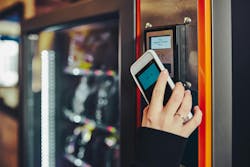How vending and micro market operators can overcome tax compliance and technology gaps
While attending this year’s NAMA Show, one thing was clear: no matter how advanced the technology or how large the operation is, unattended retail businesses continue to face significant challenges in terms of sales tax compliance and financial accuracy. Here are steps that vending and micro market operators can take to overcome tax compliance and technology gaps.
I attended the 2025 NAMA Show as both a presenter, for a session on “Financial responsibility and accounting,” and as an exhibitor. I had the opportunity to engage with many professionals, from newly launched operators to long-established companies, each navigating the shifts from vending to micro markets to unattended retail via smart markets and stores into their operations. The innovative technology presented on the exhibit floor offers a variety of new concepts, products, customer experiences and technology tools to create operational efficiencies for vending machines and micro market owners.
Action plan
-
Unattended retail operators face shared challenges in tax compliance, product taxability and software limitations, regardless of business size.
-
Technology gaps and poor data accuracy can result in overpayment or underreporting of sales tax, particularly when machine locations or product details are unclear.
-
Improved practices like accurate machine tracking, UPC use and proper resale documentation can enhance compliance, reduce audit risk and support an operator's long-term financial health.
- Limitations in technology
- Gaps between software applications
- Lack of knowledge regarding tax regulations and permitting
- License requirements
Many expressed concerns about data accuracy, unreliable information from data sources, and difficulty understanding registration and reporting requirements.
In this article, we aim to shed light on these shared challenges and explain how addressing them can enhance your business operations, leading to more informed decisions regarding automation, efficiency and long-term financial health. As the industry evolves, so must the tools and practices that support its financial health.
Registering as a retail business: What unattended operators need to know
Most states define vending machine and micro market owners as retailers: they fall into the category of “unattended retail” operators. In addition, most states and many local tax authorities require some form of permit to operate a vending machine or micro market and require retailers to register to remit sales tax based on products sold.
Once registered, the owner is obligated to report and remit sales tax to the applicable tax authorities. The filing frequency is defined by each tax authority, which is generally defined by the amount of sales tax calculated, collected and remitted. They are required to register with state tax authorities to collect sales tax because they, by definition, have established the obligation to remit sales tax on taxable vending machine sales. The permitting and registration requirements are becoming more complex, and this is compounded when an operator relocates machines to separate locations that require permitting and registration based on the new location (California, Colorado and Florida are some examples).
Why resale certificates matter: Avoiding double taxation
In previous articles, we have discussed misunderstandings related to tax-free purchases of inventory that will be sold through a vending machine or micro market. A retailer registered with a tax authority will have the ability to present a resale exemption certificate to their supplier (e.g., Vistar, Walmart, Sam’s Club), which enables them to purchase inventory products without paying sales tax.
If a retailer is not purchasing products sales tax-free, then they are at risk of double taxation. In other words, the retailer would pay sales tax on products when they are purchased, and the tax authority requires calculating and remitting sales tax when the product is sold through a vending machine or micro market. In a sales tax audit, the auditor focuses on evaluating whether you are paying the correct sales tax on products sold to customers.
Technology limitations can lead to overpayments
When working with operators using existing technological tools, devices and software systems, we have encountered situations where the amount of data is not complete enough to associate revenue with machine location (i.e., tax authority) or is not defined well enough to determine taxability of the product (i.e., vague description of product). Both conditions can result in over- or underpaying sales tax.
The location of the vending machine or micro market determines what sales tax rate should be used to calculate the sales tax liability. The owner should not use their office or storage location to determine the sales tax rate.
Other approaches can help retailers achieve better accuracy and reliable results. First, the retailer can associate the machine code/ID with the actual physical location. If the machine moves, the code/ID should remain the same, but the physical location should be updated. Then the retailer determines the applicable sales tax rate at the new location.
Second, consider using the standard UPC because this provides a complete and consistent product name. Using the UPC provides a reference to the ingredients that can be used to determine the taxability of the product.
Many systems can store sales tax rates by location; however, they do not have the capability to define the taxability of products by machine location. Therefore, an accounting process must take place outside of this system to calculate sales tax liabilities.
Product taxability is more complex than you think
Many new product offerings were showcased within the NAMA exhibit hall, including candy, energy drinks, healthy snacks, meat sticks and bites, popcorn, soft drinks, protein drinks and ice cream. Regarding product taxability, a general rule is that if a product requires refrigeration, it is considered food and therefore not subject to sales tax.
This general rule should not be applied to beverages, however, because the taxability of beverages is becoming more complex. It is therefore important to define the product correctly:
- Carbonated drink (g., soft drink/soda)
- Non-carbonated drink
- The taxability of items such as water, vitamin-enhanced water or flavored water often varies by state.
- Sparkling drink/water
- Many states treat this the same as a carbonated drink (g., Pennsylvania defines this as taxable).
- Energy drink
- Sports drink
- Sweet tea vs. unsweetened tea
- Nutritional drink
- Protein drink
- Juice
- Several states define taxability by the percentage of natural frit juice concentrate.
- Hot beverages
- Coffee is generally taxable.
Several states, including California, apply sales tax to vending machine sales differently when compared to grocery or micro market retail sales.
How to improve accuracy with better data and system updates
Consider the limitations and complex tax rules discussed in this article, and you can imagine the amount of work and potential tax calculation errors that can occur when determining the correct sales tax liability.
In my experience, many operators overpay sales tax due to system limitations, data inaccuracies, and the incorrect application of state-defined calculation rules. A few state laws related to vending machines define how sales tax is calculated on food and beverage products and other items. One of the most challenging is California — a fact that several owners echoed, whom we met during the NAMA event.
The sales factor calculation rule is defined by the combined sales tax rate of the machine location; therefore, if the rates change, your calculation rules should also be modified.
Filing tax returns and preparing for audits
The complexities of sales tax calculations often extend to the preparation and filing of sales tax returns. Each state has its own format for reporting gross sales, taxable amounts, exempt amounts, and tax collected.
Recordkeeping related to the sales tax returns that have been filed is especially important because they can be reviewed and examined by the tax authority during a sales tax audit. The average statute of limitations for sales tax is three years; therefore, owners should plan to keep copies of tax returns and supporting documents for a minimum of three years.
Many businesses feel that compliance ends after they file their returns. The real key to compliance lies in the backup information and records that support the returns, which become the basis of your defense if you are ever audited.
Key takeaways for convenience services operators
In conclusion, this article provides a comprehensive overview of the key financial and regulatory challenges faced by convenience services operators, based on our industry experience and observations at the 2025 NAMA Show.
Despite the diversity in business size and experience, operators consistently struggle with similar issues such as:
- Complex state and local registration requirements
- Sales tax compliance
- Product taxability
- Technological limitations in tracking and reporting accurate data
This article is intended to emphasize the importance of accurately registering with tax authorities, utilizing resale exemption certificates to avoid double taxation, and understanding product-specific tax regulations, particularly for beverages.
Additionally, poor data quality and system limitations can result in incorrect tax calculations and overpayment. To improve accuracy, we recommend:
- Associating machine IDs with physical locations
- Using UPC to determine product taxability
- Maintaining detailed records to support tax return filings
I cannot emphasize enough the need for better automation and informed practices to enhance compliance and long-term financial health in the unattended retail industry.
Read more tax advice for convenience service operators on VendingMarketWatch.com
About the Author

Scott Walters
Scott Walters is the co-founder and CEO of Tacs LLC. Scott has worked for over 30 years with a focus on sales and use tax. He has extensive experience in the implementation of tax technology to simplify the accounting process. Scott’s background includes multiple roles at leading tax technology companies as well as a director at the Tier 1 accounting and consulting firm PWC. He can be reached at [email protected] or 865-304-3212.

